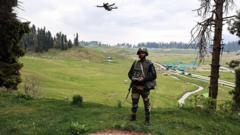Following India's recent air strikes against purported militant positions in Pakistan, experts weigh in on the escalating tensions between the nuclear rivals and speculate on Pakistan’s possible responses, as well as diplomatic maneuvers needed to prevent further conflict.**
Escalating Tensions: Analyzing India's Recent Strikes and Pakistan's Potential Response**

Escalating Tensions: Analyzing India's Recent Strikes and Pakistan's Potential Response**
A deep dive into the latest India-Pakistan conflict, highlighting the implications of India's air strikes and the likely response from Pakistan amidst heightened tensions.**
In a significant and alarming escalation, India recently launched air strikes on nine locations across Pakistan and Pakistan-administered Kashmir, targeting alleged militant positions. The strikes, which occurred swiftly within a 25-minute time frame, were reportedly based on what India characterized as "credible intelligence." Residents of the region were jolted awake by the sounds of the explosions, heightening the anxieties already simmering between the two nuclear-armed nations.
Pakistan, however, challenged India's narrative by stating that only six locations were actually targeted and claimed to have downed five Indian fighter jets, a statement that India has yet to confirm. The aftermath saw casualties on both sides, with reports of at least 26 deaths and numerous injuries in Pakistan, while Indian forces noted 10 civilian lives lost due to retaliatory cross-border shelling.
The air strikes are seen as a direct response to a recent militant attack on tourists in Pahalgam, indicating a marked intensification of tensions that had remained relatively high since previous conflicts. Experts suggest that this military maneuver by India may represent a new phase in its strategy, focusing on multiple militant groups such as Lashkar-e-Taiba and Jaish-e-Mohammed more aggressively than in past strikes.
The nature of India's approach — described by analysts as a "Balakot plus" strategy that is wider in scope than past operations — targets various terrorist infrastructures across the border, signaling a clear intent to re-establish deterrence against Pakistani-sponsored militancy. Yet, this bold move invites the prospect of retaliatory action by Pakistan. Observers highlight that Pakistan’s military's commitment to retaliatory measures and public sentiment could pressure military leaders into conducting surgical strikes of their own.
While some analysts caution that the potential for an escalating military conflict is high, others contend that there remains a chance for de-escalation through diplomacy. The history of past escalations reveals a complex interplay of military actions and diplomatic negotiations, often requiring a deft handling of public emotions and international pressures.
Amidst the rising tensions, both countries have implemented various defensive measures and restrictions, mirroring moves made during earlier crises. Nevertheless, the hope for diplomatic engagement remains as critical as ever to prevent further escalation, as leaders on both sides confront a rapidly changing geopolitical landscape. The situation remains fluid as many anticipate whether Pakistan will react aggressively or opt for restraint in the coming days.

















